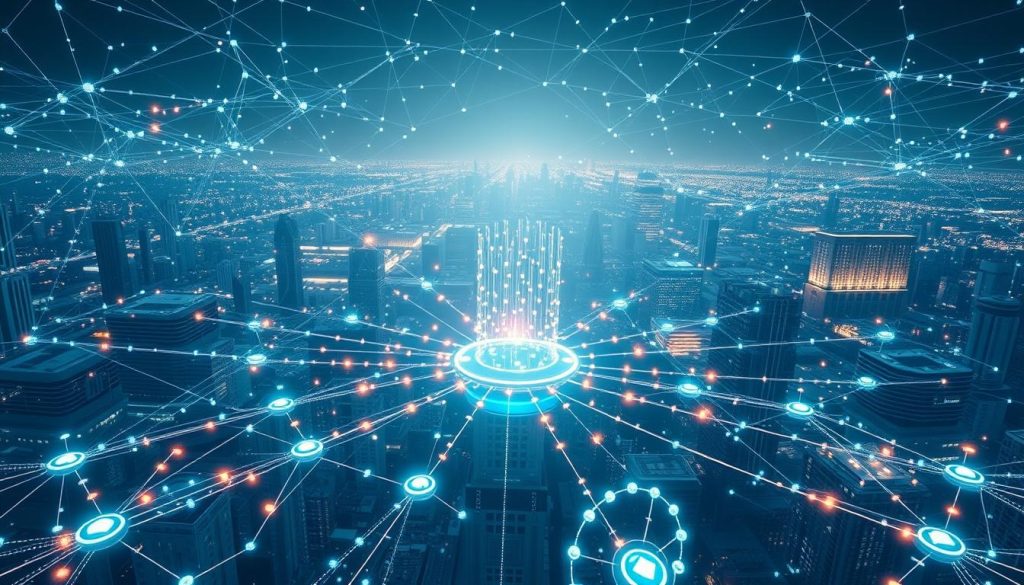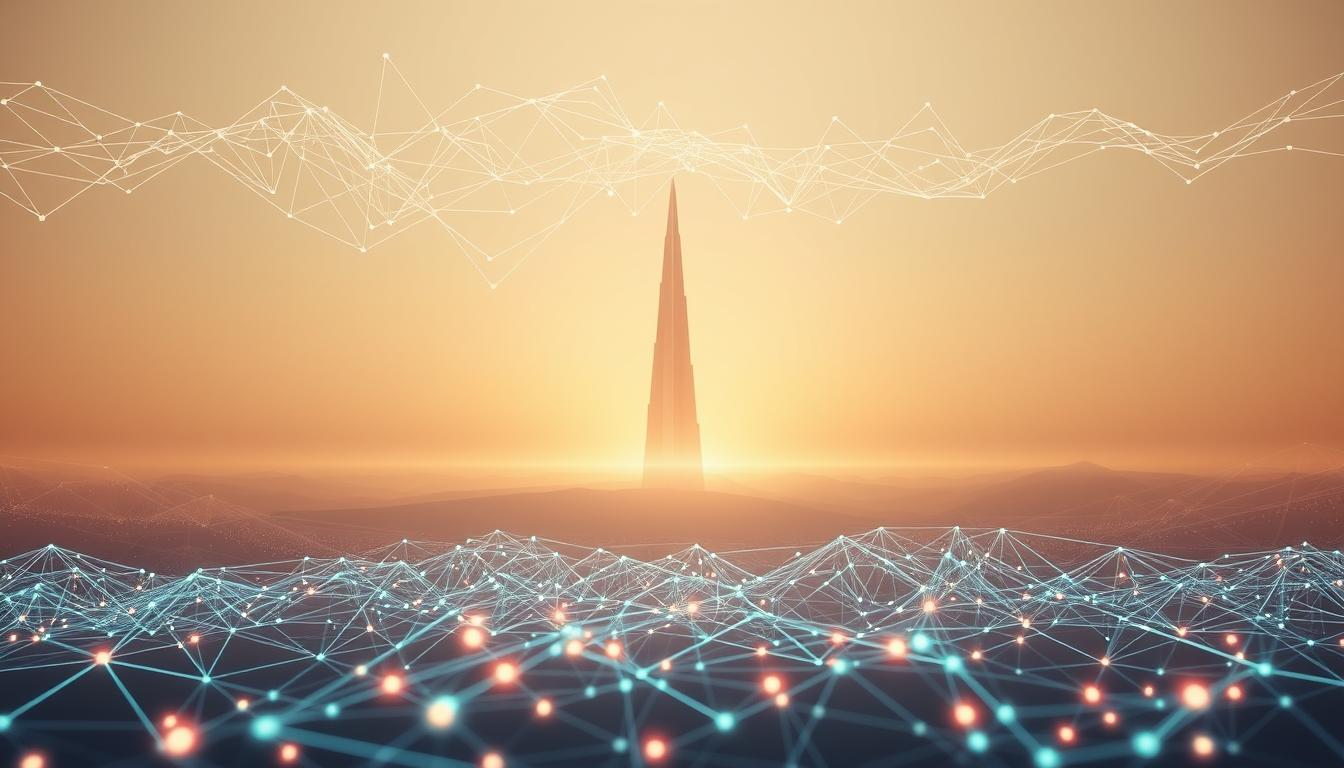The digital revolution has brought a new kind of wealth. It’s not just money; it’s knowledge, creativity, and innovation. Companies like OpenAI and Google DeepMind show how artificial intelligence can create billions of dollars from just ideas.
Blockchain changes how we handle these mental assets. Bitcoin showed us that digital things can be scarce. Ethereum showed us that money can be programmed. Now, our thoughts, algorithms, and creative works can be traded on global markets.
Think of how Netflix changed the game for Blockbuster or how Tesla changed transportation. These companies didn’t just sell products. They sold innovation itself. The mix of artificial intelligence and blockchain opens up new ways to turn brainpower into assets.
Traditional finance has trouble valuing things we can’t touch. Banks can value real estate but struggle with patents or AI models. Blockchain fixes this by making markets for cognitive capital clear. Smart contracts make trades happen automatically. Cryptographic proofs prove ownership. And decentralized networks keep the market fair.
This change affects everyone from Microsoft developers to artists on OpenSea. Knowledge workers can now make money from their skills. Small teams can compete with big companies. And with blockchain, there are no borders when trading cognitive capital.
Key Takeaways
- Cognitive capital transforms knowledge and creativity into tradeable digital assets
- Blockchain technology enables secure ownership and exchange of intellectual property
- Artificial intelligence amplifies human creativity to generate new forms of value
- Traditional financial systems struggle to price intangible assets effectively
- Smart contracts automate complex intellectual property transactions
- Decentralized markets democratize access to cognitive resources globally
Understanding the Foundation of Cognitive Capital in the Digital Age
The digital revolution has changed how we think about wealth. Now, knowledge, skills, and ideas have economic value. This shift changes our view of assets in the 21st century.
What is Cognitive Capital?
Cognitive capital is the economic value of human knowledge and skills. It’s the worth of ideas, expertise, and creativity. Companies like OpenAI and DeepMind show this every day, turning research into billions.
This new asset class includes:
- Patents and intellectual property
- Proprietary algorithms and AI models
- Specialized knowledge and expertise
- Creative works and innovations
The Intersection of Human Intelligence and Technology
Human creativity and machine learning open new doors. Technology boosts our thinking abilities. A single researcher at MIT can now do what used to take a team.
Stanford’s AI labs show how digital assets come from this mix. Google’s DeepMind solved a big problem that scientists had for years. These achievements show cognitive capital in action.
Why Cognitive Assets Matter More Than Ever
Today, success is measured by what we know and create. Traditional making things is going down, but knowing things is going up. This makes cognitive capital key to growth.
Research places now count their contributions. They track patents, papers, and big discoveries. These numbers decide funding and partnerships. The knowledge economy values those who create and manage digital assets well.
How Blockchain Technology Enables the Tokenization of Knowledge
The digital world has changed how we share and value knowledge. Blockchain technology now lets us turn ideas and research into digital assets. This is done through tokenization, which makes intellectual property into digital tokens for trading on decentralized networks.
Smart Contracts as the Building Blocks of Intellectual Property
Smart contracts change how we handle intellectual property rights. These programs on platforms like Ethereum and Polygon enforce agreements automatically. When you buy a tokenized patent or research paper, the smart contract gives you ownership and pays creators.
Imagine smart contracts as digital vending machines for ideas. They give you access to intellectual property after payment. This cuts down on legal costs and speeds up sharing ideas.
Decentralized Storage and Verification of Cognitive Assets
Old storage systems can lose or tamper with data. But blockchain networks with decentralized storage like IPFS and Arweave keep data safe. They spread data across thousands of computers, making sure research and creative works stay available forever.
Creating Immutable Records of Innovation
Every innovation on blockchain is part of an unchangeable history. This protects inventors by marking when they created something. It helps universities, labs, and creators prove their work, preventing disputes and encouraging teamwork.
The Revolutionary Impact of AI on Asset Creation and Valuation
Artificial intelligence has changed how we make and value digital assets. Companies like OpenAI and Anthropic show this change every day. They use AI to make lots of content, code, and insights that are worth money. This is a big change in our digital world.
AI makes things fast and in huge amounts. ChatGPT can write marketing campaigns, and Claude can create software. These things become valuable ideas. Each one could make money. The line between human and machine creativity is getting smaller as AI makes things on its own.
How we value digital things has changed too. Now, machines figure out what things are worth. Google DeepMind’s AlphaFold can predict protein structures, which could be worth billions in medicine. AI doesn’t just make things; it also sets their prices using patterns and predictions.
Adding cryptocurrency markets makes things even more interesting. Blockchain helps set clear prices for AI-made things. Smart contracts can make trades based on AI prices. This means a new market where digital goods trade like stocks. Machines can now make and price digital items as they go.
Stablecoins, Digital Assets, the Genius Act, AIx Asset
The digital economy is changing how we handle intellectual property. New systems are coming up to deal with AI-created content and knowledge. This marks a big change in how we see ownership and value in the AI age.
Breaking Down the Genius Act Framework
The Genius Act is new legislation that wants to give AI-created intellectual property rights. It says that digital assets made by AI should have the same legal protection as human-made ones. The act sets rules for registering, protecting, and sharing AI innovations.
Key parts include:
- AI systems can be seen as creators under certain conditions
- AI-generated content gets ownership rights
- There are clear ways to license and sell AI innovations
- There are ways to stop unauthorized use of AI assets
AIx Asset: Bridging AI Innovation and Blockchain
AIx Asset is a leading platform that links AI innovations with blockchain. It lets creators turn their AI content into tokens for trading on decentralized markets. The platform uses smart contracts to make sure creators get paid fairly for their digital assets.
“The future of innovation lies at the intersection of AI creativity and blockchain transparency. AIx Asset makes this future accessible today.”
The Role of Stablecoins in Cognitive Capital Markets
Stablecoins are key for stable markets in cognitive assets. Unlike regular cryptocurrencies, stablecoins like USDC and Tether keep a steady price. This makes transactions predictable and lowers the risk in trading knowledge assets.
| Stablecoin Type | Market Cap | Use in AI Markets |
|---|---|---|
| USDC | $24.5 billion | Primary payment for AI licenses |
| Tether (USDT) | $83.2 billion | Cross-border AI asset trades |
| DAI | $5.3 billion | Decentralized AI marketplaces |
These stablecoins help build a solid base for cognitive capital markets. Here, innovators can price and trade their ideas with confidence.
Decentralized Finance and the Democratization of Cognitive Resources
Decentralized finance is changing how we use and trade brain power around the world. Old financial systems often shut out new ideas because of where you are or who you know. But DeFi protocols open up markets for everyone to join.
Top platforms are finding new ways to use smart ideas. Aave and Compound let users borrow against things like research papers and AI models. They decide value through community votes, not just one person.
| Platform | Cognitive Asset Type | Average Loan-to-Value Ratio |
|---|---|---|
| Ocean Protocol | Data Sets & AI Models | 65% |
| SingularityNET | AI Services | 70% |
| Aave (Experimental) | Tokenized Patents | 50% |
This change means a researcher in Bangladesh can make money from their AI without Silicon Valley help. Small teams can get funding for their big ideas through online exchanges that work all day, every day.
Getting rid of old rules speeds up new ideas. Anyone can list their smart ideas on platforms where value comes from usefulness, not just who you know. This way, creators from everywhere can play a fair part in the global knowledge market.
Smart Contracts: Automating the Exchange of Intellectual Capital
The digital age needs faster, more efficient ways to trade knowledge and ideas. Smart contracts are the answer, changing how we handle intellectual capital. They run on blockchain networks, creating a trustless space where innovation flows freely.

Programming Trust into Knowledge Transactions
Before, trading knowledge was slow and needed lawyers and agents. Smart contracts change this. They encode business logic into code, executing automatically when conditions are met.
This automation ensures creators get paid instantly when their intellectual capital is used. The beauty is in transparency. Every transaction is visible on the blockchain, yet privacy is kept through encryption.
Creators set their terms once, and the system handles everything else. No more chasing payments or worrying about contract breaches.
Real-World Applications of Cognitive Smart Contracts
Major organizations already use this technology. Algorand partnered with SIAE, Italy’s largest copyright collection agency, to manage music rights for over 95,000 artists. Their smart contracts process millions of transactions, ensuring artists get paid fairly and quickly.
IBM leads innovation with its blockchain patent system. Scientists and inventors register their discoveries through smart contracts, creating timestamped proof of ownership. This automation speeds up the patent process from months to days.
Reducing Friction in Innovation Markets
API calls to AI services show the power of micropayments through smart contracts. Developers pay tiny amounts for each AI query automatically. This system encourages experimentation and innovation without complex billing arrangements.
Legal costs drop dramatically when automation handles licensing. Small creators benefit most, accessing global markets without expensive intermediaries. The result is a vibrant ecosystem where intellectual capital flows to its highest value use, benefiting everyone involved.
Cryptocurrency as the Native Currency of the Knowledge Economy
The digital world has changed how we trade ideas. Traditional banks can’t keep up with the speed and detail needed. This is where cryptocurrency comes in, as a natural fit for the knowledge economy.
Why Traditional Money Falls Short for Cognitive Transactions
Banks take days to process payments, not seconds. Credit card fees are 3-5% of every transaction. Wire transfers cost $25-50, no matter the amount. These issues make traditional money hard to use in the knowledge economy.
Imagine paying for a five-minute AI algorithm or a single data insight. The fees would be more than the service’s value. Cryptocurrency fixes this with fast transactions and low fees.
Micropayments for Micro-innovations
Bitcoin’s Lightning Network handles payments as small as one satoshi (0.00000001 BTC). Ethereum’s Layer 2 solutions, like Polygon, do the same. These technologies open up new business models in the knowledge economy:
- Pay-per-query AI services charging fractions of pennies
- Real-time licensing of patented algorithms by the second
- Streaming payments for continuous data feeds
Specialized tokens also boost this ecosystem. Fetch.ai (FET) and SingularityNET (AGIX) are examples. They power autonomous agents and marketplaces for AI services, making micropayments possible. These cryptocurrencies don’t just transfer value—they create new ways to monetize ideas.
Future Implications: Building a Global Cognitive Capital Marketplace
The next decade will see a new global marketplace. Here, ideas, algorithms, and AI innovations will trade like stocks. This change marks the evolution of finance, where cognitive capital is the key to innovation.
Big tech companies like Microsoft and Amazon are setting the stage. They’re building systems to value, protect, and trade AI assets worldwide. They see cognitive capital as the driver of future economic growth.

Groups like IEEE and ISO are working on standards for AI assets. These standards will help value AI assets clearly across industries and countries. Without them, the global market for knowledge assets won’t reach its full potential.
Countries are racing to create rules that support innovation and protection. Singapore, Switzerland, and Estonia are leading with smart policies. The United States is close behind, with laws to establish AI ownership rights.
This new market will be open 24/7. Inventors in Tokyo can instantly license their algorithms to Silicon Valley startups. Smart contracts and blockchain will make transactions secure and transparent. This means anyone with great ideas can earn from their cognitive capital in the future finance world.
Conclusion
The mix of AI and blockchain is changing how we share and value knowledge. Now, ideas are more important than physical things for making money. This change lets creators from all over the world join the global economy.
Stablecoins like USDC and Tether help this new market grow. Smart contracts on Ethereum make deals clear and safe. With AI from OpenAI and Google DeepMind, ideas can be traded and protected like never before.
This new world lets millions make money from their talents. Whether you’re a coder in Silicon Valley or an artist in Tokyo, you can join the knowledge economy. It’s not just about tech; it’s about making everyone’s insights valuable.
As we go forward, AI and blockchain will keep changing our views on work and wealth. The tools are ready, the system is growing, and the chances are endless. Now, it’s up to us to use these technologies to make knowledge the most valuable thing.
FAQ
What exactly is cognitive capital and how does it differ from traditional assets?
Cognitive capital is the value of knowledge and skills enhanced by AI and blockchain. It’s different from physical assets like real estate. It includes things like algorithms and AI models that can be traded.
Companies like OpenAI and DeepMind show how research can become valuable assets.
How do stablecoins fit into the cognitive capital marketplace?
Stablecoins like USDC and USDT help by keeping prices stable for trading knowledge assets. They make it easier to price and trade innovations. This stability helps researchers and developers without worrying about price changes.
What is the Genius Act and how does it affect AI-generated content?
The Genius Act is a proposed law that protects AI-generated intellectual property. It aims to give legal rights to AI-created content. This is a big step towards recognizing AI’s role in creating valuable property.
Can you explain what AIx Asset is and how it works?
AIx Asset is a platform that connects AI innovations with blockchain. It lets creators turn their AI models into tradable assets. It’s like a marketplace where developers can list their work and get paid automatically.
How do smart contracts automate the exchange of intellectual capital?
Smart contracts are self-executing agreements that handle knowledge transactions. For example, they can automatically pay for AI model access. This makes transactions fast and secure, like Algorand’s copyright management with SIAE.
What role does decentralized finance (DeFi) play in democratizing cognitive resources?
DeFi platforms like Aave and Compound make it easier to finance cognitive assets. They allow lending against AI models, helping small teams monetize their work. Platforms like Ocean Protocol and SingularityNET show how data and AI services can be shared openly.
Why is cryptocurrency better suited for cognitive capital transactions than traditional money?
Cryptocurrency is great for cognitive capital because it supports micropayments. It’s fast and cheap, perfect for small payments. Tokens like FET and AGIX are designed for easy value transfer in AI markets.
How does blockchain technology ensure the security and verification of cognitive assets?
Blockchain keeps records of innovations safe through decentralized storage. Systems like IPFS and Arweave ensure permanent preservation. Platforms like Ethereum and Polygon make sure ownership is clear, preventing theft.
What does the future hold for global cognitive capital marketplaces?
The future sees global markets for AI assets, open 24/7. Standards for valuing AI are being developed. Companies like Microsoft and Amazon are getting ready for these exchanges. Nations are creating rules to support this new economy.
How can individuals and small organizations participate in the cognitive capital economy?
Thanks to tokenization and DeFi, individuals and small teams can monetize their innovations. Platforms like Ocean Protocol and SingularityNET let them list and price their assets. It’s all about having valuable knowledge or AI models to share.

Leave a Reply